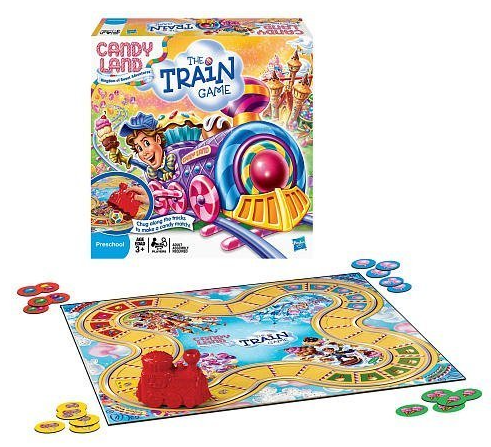 |
| Chug along the tracks to make a candy match. |
In the box: Game board, plastic train, custom die, 20 tokens
Candy Land Train is made by the makers of the classic Candy Land board game, but other than that, it doesn't remind me much of Candy Land. The game board for Candy Land Train has four stations, one in each corner. You can see on the image above that each station has tokens that are a different color (red, blue, green, yellow). Each station also has just one type of treat (cotton candy, gum ball, ice cream cone, sucker). Each of the tokens will show either one, two or three of the items.
The goal of the game is to travel around the board and collect a treat token from each train station (any one of each color). Your journey will be via a red, plastic train engine. The train is hollow and will be placed on top of a 12-sided color die before chugging off. Four sides of this die have all four colors on them, these are the rainbow sides. The other eight sides each have only one color on them. The die is a lightweight plastic and the colors on the die are stickers. The die will tumble under the train as it moves so that you will never know which color will be up when you lift the train.
Object:
Be the first player to collect a candy token from each train station.
Set up:
Place the board in the middle of the players. Place the die anywhere on the tracks and place the train on top of it.
Play:
The first player pushes the train to any of the four stations. Check the color of the token that is available at that station. Now lift the train and see if the color on the top of the die matches the color of the token. If it does, take a token. Now you only have three left to collect. If a rainbow side is showing, you can collect a token no matter which station you are at since it covers all four colors. If it does not match, place the train back on top of the die and the next player pushes the train to any of the stations. The train can move in either direction and can be pushed to any station on any turn. As you collect tokens, push the train only to the stations where you still need to collect a token.
Alternate Play:
Play as above, but each time you collect a token choose a token that pictures the most pieces possible. For instance, if there is a token with one gum ball and a token with three gum balls available, take the one picturing three gumballs. Play until all the tokens have been taken. Then each player counts the number of treats pictured on the tokens. The one with the most treats is the winner.
Try this:
- Skip the game and play with the tokens, sorting them into piles by either color or number of items. Hold several in the dominant hand and push them out with the thumb one at a time to drop into piles.
- Push the train to the stations, but keep the die out. Cup the hand and hold it in that position as you roll the die for several seconds. Then throw onto the playing surface.
- Stack the coins by each station. Can you pick the top coin off the stack without disturbing the others?
- Place the coins one-high on the playing surface before clean up. Pick them up one at a time and squirrel into the palm. How many can you hold? Put them back into the box by the handful.
- Follow the directions from the suggestion above, but this time you call the color each time for the individual to pick up. Or let the individual name the color each time he picks up a token.
- Trace visually the path you will take before pushing the train ahead each turn.





